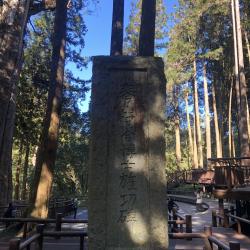Kawai Shitaro visited Alishan in Chiayi in May 1902 and found that Alishan had excellent forestry, good materials and abundant resources. Afterwards, Dr. Hehe's opinions played a key role in several important surveys and forestry management planning. Dr. Kawai played a major role in the development of Alishan forestry. In the 6th year of Showa (1931) March 14, Dr. Kawai passed away in Tokyo, Japan. In honoring his achievements, posterity erected the Kinzan Dr. Kawai Monument in Alishan in November, Showa 7 (1932). It was officially unveiled on February 3, Showa 8 (1933), and designated as a county historic site in 2009.
Tsou
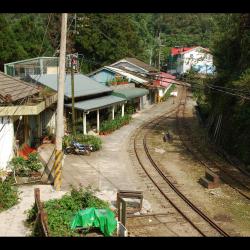
Shitzulu Station was opened in October of the first year of Taisho (1912). It is a stop of the Alishan Forest Railway, with an altitude of about 1,530 meters. Before the Alishan highway was opened, Shitzulu was the traffic hub in the village, and also the most interacted village and closest to indigenous villages. Since it is located in the midpoint between the Alishan Forest Railway and the Tefuye hamlet of the Cou tribe, the station connects Laiji and Tefuye hamlets. Therefore, the nearby hamlets like Tsatsaya, Shanmei, Lalauya, Laiji, Tefuye had earlier contact with the outside world than other tribes due to their location.
Today, most of the residents of Shitzulu village are descendants of loggers from the Japanese occupation period or employees of the Alishan Forest Railway. In the past, the area was quite developed because there is a train station as well as simple power supply equipment, a post office, and other facilities. However, after the opening of the Alishan Highway, the function of the railway station died away.
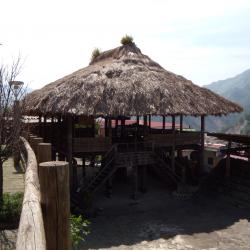
Cou people believe that the existence or failure of a tribe is dependent on the existence or non-existence of the men’s meeting house (Kuba). The housing facilities inside the settlement are the reflection of the operation of the social system. The settlement is the tribal integration center, and its symbolic building is the Kuba. All political, economic, religious, and other public affairs of the tribe must be carried out inside the kuba. The kuba is built in the center or at the entrance of the settlement and is the largest building in the tribe. There is a fire pit in the center of the kuba. Traditionally, the fire must be lit all year round, which symbolizes the continuous life of the tribe. As it has a thatched roof, the fire cannot be too fierce. The square in front of the kuba is a place for tribal ceremonies, judicial arbitration, and other public affairs. There is a sacred tree and an altar below it on the north side of the square. It is a sea fig tree (Yono), which is the ladder for the gods to descend from the sky.
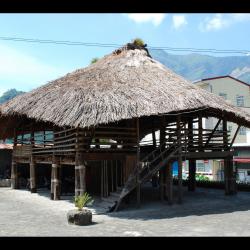
Cou people believe that the existence or failure of a tribe is dependent on the existence or non-existence of the men’s meeting house (Kuba). The housing facilities inside the settlement are the reflection of the operation of the social system. The settlement is the tribal integration center, and its symbolic building is the Kuba. All political, economic, religious, and other public affairs of the tribe must be carried out inside the kuba. The kuba is built in the center or at the entrance of the settlement and is the largest building in the tribe. There is a fire pit in the center of the kuba. Traditionally, the fire must be lit all year round, which symbolizes the continuous life of the tribe. As it has a thatched roof, the fire cannot be too fierce. The square in front of the kuba is a place for tribal ceremonies, judicial arbitration, and other public affairs. There is a sacred tree and an altar below it on the north side of the square. It is a sea fig tree (Yono), which is the ladder for the gods to descend from the sky.
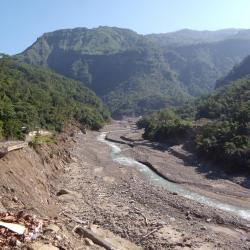
The Limei hideout trail that is located in Shanmei village and Lijia village in Alishan Township, Chiayi County used to be the main path from Tsou’s Shanmei hamlet to Lijia hamlet. Starting from Shanmei hamlet, walk along the trail on the left bank of the Zengwen River, enter the Danai Valley, then climb the small branch on the west side of Yueyana Mountain to pass by Yofuni, you will arrive at Lijia hamlet. After the Alishan Highway was opened to traffic, this hideout trail has been abandoned for many years. When the trail was destroyed by Typhoon Morakot in 2009, people of the hamlet began to propose to the Forest Service Bureau to repair this historic trail. Other than for emergency relief, this area was also developed for tourism purposes. The Limei hideout trail was opened in 2013, with a total length of about 2.1 km.
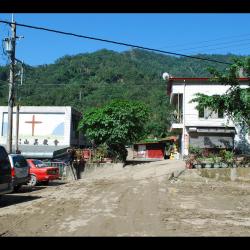
Shanmei Hamlet is located in Shanmei village in Alishan Township, Chiayi County. It was originally the location for Shamijishe, a small community of the larger Dabang group. It used to be scattered in the southern base of Mount Sapiji above the present site. However, due to a landslide in the early days of the Japanese occupation, the people moved south to Shamiji and lived close to the police post, where they continued to use the old name. At that time, there were only 2 households with 14 people. In the early post-war period, the number increased to 58 households with 260 people. When the National Government established an administration hub, the name of the hamlet was directly transliterated into Shanmei village.
Today, Shanmei hamlet has schools, a police station, farmers’ association, offices, churches, etc. It is the center of Alishan Township.
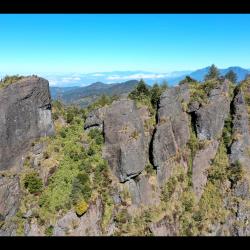
Tashan is one of the Alishan mountain ranges. The mountain ranges from east to west. The rock formations are arranged horizontally and stacked on top of each other like a tower. The main peak of Tashan Mountain is 2,663 meters above sea level. It is the holy mountain of the Tsou tribe. The traditional name is Hocubu, which has a meaning of the goblins’ nest and home to the spirits. Tsou people believe that the spirits live on Tashan after death, and that the good spirits live on Big Tashan, while the evil spirits live on small Tashan. Small Tashan is 2,484 meters above sea level, and its traditional name is Maeno, which means peak.
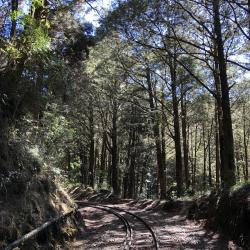
The Mianyue Line of the Forest Railway is located inside the Alishan National Forest Recreation Area. It was completed in 1915 and is about 14 km in length from Alishan old station to Songshan station. There are two stations along the way, mainly Tashan and Mianyue. In 1934, the Mianyue Line was dismantled because the logging operation was terminated. In the early post-war period, due to the need for afforestation along the Alishan Forest Railway, the National Government restored the railway up to the Shihou section. However in recent years, the Mianyue Railway has suffered severe damage from the Jiji earthquake and Typhoon Morakot, and is until today still impossible to pass.
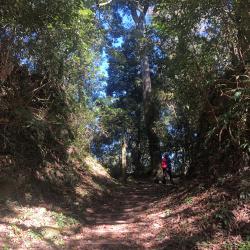
The Tfuya Historic Trail, which straddles the junction of Alishan Township in Chiayi County and Xinyi Township in Nantou County, mainly leads from Tfuya to Zizhong. It was a path that the Tsou people used for hunting, wedding, and visiting families in the past. In addition, it can be connected to Tataga and all the way to the Yushan area, which is an important passage for connecting Alishan and Yushan. In the middle of the Japanese occupation period, the Government-General in Taiwan rebuilt the old trail adjacent to Zizhong into an old railway on the Shuishan Line, which was used to transport timber. The railway was abandoned in 1977 and in 2001, the 6.32 km long trail that goes from Tfuya to Zizhong was refurbished, preserving the original railway pavement, which is the Tfuya Historic Trail known today.
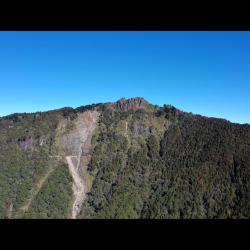
Tashan is one of the Alishan mountain ranges. The mountain ranges from east to west. The rock formations are arranged horizontally and stacked on top of each other like a tower. The main peak of Tashan Mountain is 2,663 meters above sea level. It is the holy mountain of the Tsou tribe.
The traditional Tsou name is Hocubu, which has a meaning of the goblins’ nest and home to the spirits. Tsou people believe that the spirits live on Tashan after death, and that the good spirits live on Big Tashan, while the evil spirits live on small Tashan. Small Tashan is 2,484 meters above sea level, and its traditional name is Maeno, which means peak.
